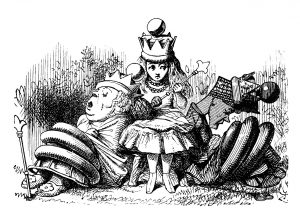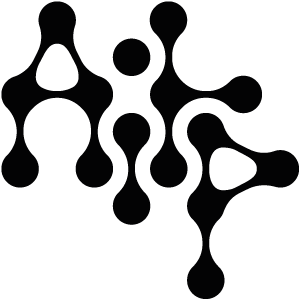El poema nonsense Jabberwocky surt a la novel·la de Lewis Carroll “A través del mirall”, segona part de les aventures de l’Alícia. D’aquest poema, que té moltes paraules sense sentit, se’n han fet diverses paròdies. Aquí se’n presenta una en la que hi surten més de vint-i-cinc elements químics.
Molt probablement la paraula Jabberwocky no t’és del tot estranya. És el monstre que apareix de forma secundària a la segona part de les aventures d’Alícia, la titulada “A través del mirall”. Al començament d’aquesta novel•la hi ha un episodi no central de la novel•la, on hi surt el poema Jabberwocky, on es parla d’un monstre denominat Jabberwock ,i d’un noi que li fa front i que al final el mata. I si no has llegit la novel•la, potser has vist alguna de les pel•lícules recents sobre l’Alícia, de Tim Burton o de James Baker, o fins i tot dels Monthy Pyton. A les pel•lícules el Jabberwock hi surt amb més protagonisme que a la novel•la.
Aquest poema s’ha convertit en el paradigma de la literatura nonsense, la literatura sense sentit, on es fan servir paraules inventades i conceptes no definits, construint una peça litarària amb sonoritat i amb aparença lògica. Lewis Carroll va ser un dels impulsors d’aquest tipus de literatura al Regne Unit, on sempre ha tingut un cert seguiment.
Quina relació té tot plegat amb la Taula Periòdica? Un moment, que hem d’acabar d’introduir el poema. Heus-lo aquí en el seu anglès original:
Jabberwocky
’Twas brillig, and the slithy toves
Did gyre and gimble in the wabe;
All mimsy were the borogoves,
And the mome raths outgrabe.
“Beware the Jabberwock, my son!
The jaws that bite, the claws that catch!
Beware the Jubjub bird, and shun
The frumious Bandersnatch!”
He took his vorpal sword in hand:
Long time the manxome foe he sought—
So rested he by the Tumtum tree,
And stood awhile in thought.
And as in uffish thought he stood,
The Jabberwock, with eyes of flame,
Came whiffling through the tulgey wood,
And burbled as it came!
One, two! One, two! And through and through
The vorpal blade went snicker-snack!
He left it dead, and with its head
He went galumphing back.
“And hast thou slain the Jabberwock?
Come to my arms, my beamish boy!
O frabjous day! Callooh! Callay!”
He chortled in his joy.
’Twas brillig, and the slithy toves
Did gyre and gimble in the wabe;
All mimsy were the borogoves,
And the mome raths outgrabe.
Molts termes són nonsense, com és fàcil de veure. Però el resultat és més o menys comprensible, per poc anglès que sàpigues.
Aquest poema s’ha traduit de mil formes diferents, en tots els idiomes diverses vegades, amb sonoritats i mètriques variades. Vegeu el meu blog especialitzat https://alicies.wordpress.com/jabberwocky/ on n’hi ha vint-i set idiomes amb més de vuitanta versions diferents. Allà s’hi poden trobar diferents versions en català.
No són només traduccions, sinó que s’han fet també paròdies i adaptacions a diferents entorns . El 1993 Mark Stewart, professor d’una escola de secundària de Montgomery (New Jersey, EUA) va llegir una versió del Jabberwocky que usava noms de ciutats i pobles del seu estat com a verbs. Naturalment pels que no som de New Jersey no ens diu res. Però a Stewart li va venir la idea d’escriure el Chemowocky, amb noms d’elements químics. Fer una barreja de la Taula Periòdica i el Jabberwocky deu ser un somni per s alguns químics, i això és el que va acabar escrivint:
Chemowocky
Twas Boron, and the Silicon
Did Carbon in the Cadmium;
All Merc’ry were the Lanthanides
And the Molybdenum.
Beware the Hydrogen, my son!
The teeth that bite! The chops that chum!
Beware the Bismuth bird, and shun
The dread Beryllium!”
He Gold his Cobalt blade in hand,
Long time the Fluorine foe he Zinc,
Till rested he by a Krypton tree
And Strontiumed to think.
And as in Argon thought he stood,
The Hydrogen, with Iodine,
Came Radon through the Tungsten wood
And Sulfured Astatine!
One two! one two! and through and through
The Cobalt blade went Scandium!
He left it dead, and with its Lead
He went Gallium back.
“And hast thou slain the Hydrogen?
Come to my arms, Antimony!
O Copper morn! Neon! Xenon!”
He Nickeled in his glee.
‘Twas Boron, and the Silicon
Did Carbon in the Cadmium;
All Merc’ry were the Lanthanides
And the Molybdenum.
El monstre es diu aquí Hidrogen, i el noi que el mata Antimoni. En el text es citen explícitament 28 elements, i els lantànids, que són quinze més. Alguns elements els transforma en verbs (gold, nickeled, sulphured, strontiumed, zinc), però no és tan estrany. En català també diem daurar, niquelar, platejar, sulfurar, cincar, clorar,… que són operacions industrials.
No, l’Alícia no surt al poema. Lewis Carroll devia pensar que la nena hauria patit massa si s’havia d’enfrontar amb un monstre.
